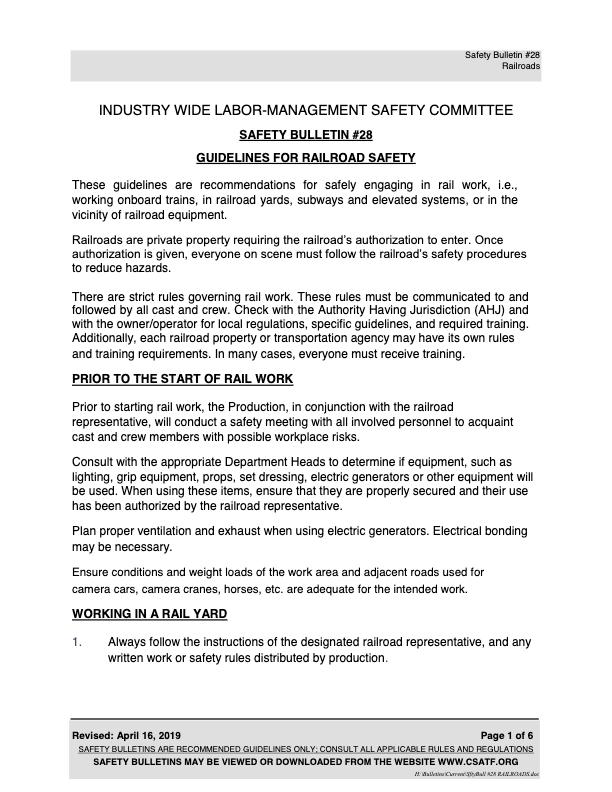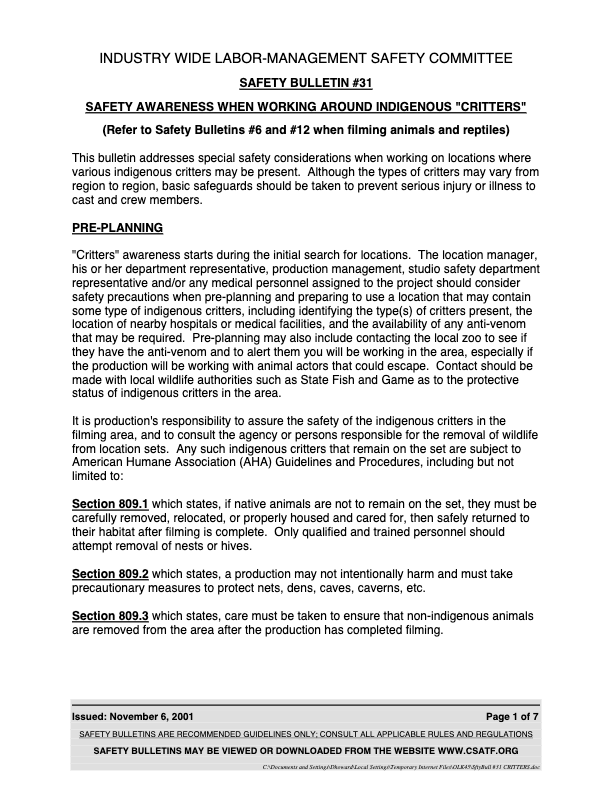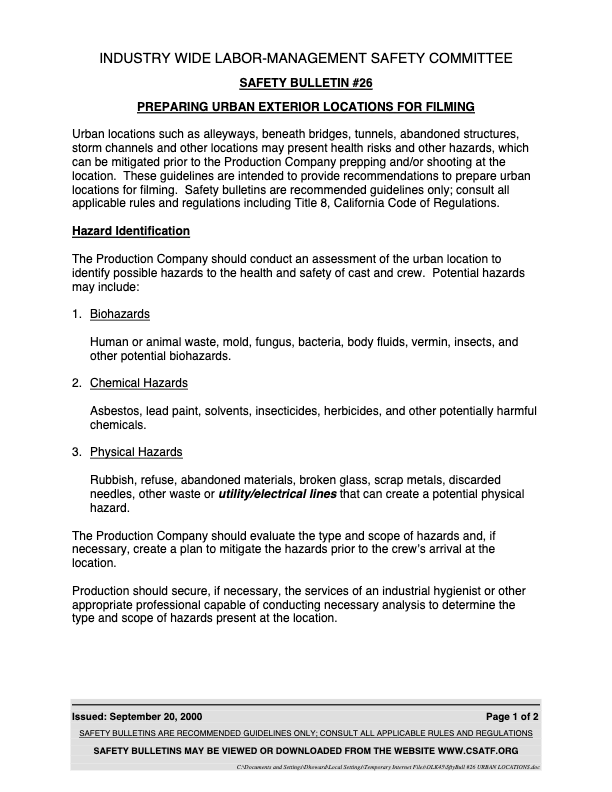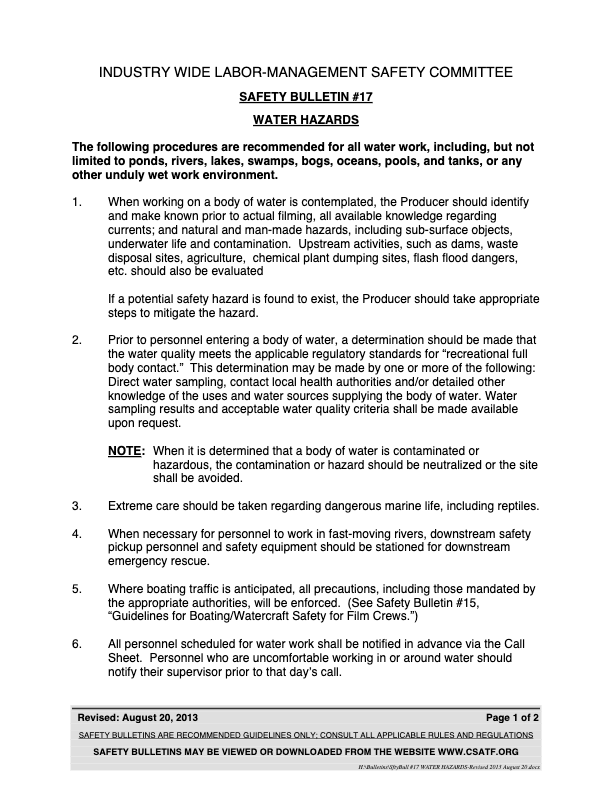Safety Bulletin

Guidelines
These guidelines are recommendations for safely engaging in rail work, i.e., working onboard trains, in railroad yards, subways and elevated systems, or in the vicinity of railroad equipment.
Railroads are private property requiring the railroad’s authorization to enter. Once authorization is given, everyone on scene must follow the railroad’s safety procedures to reduce hazards.
There are strict rules governing rail work. These rules must be communicated to and followed by all cast and crew. Check with the Authority Having Jurisdiction (AHJ) and with the owner/operator for local regulations, specific guidelines, and required training. Additionally, each railroad property or transportation agency may have its own rules and training requirements. In many cases, everyone must receive training.
PRIOR TO THE START OF RAIL WORK
Prior to starting rail work, the Production, in conjunction with the railroad representative, will conduct a safety meeting with all involved personnel to acquaint cast and crew members with possible workplace risks.
Consult with the appropriate Department Heads to determine if equipment, such as lighting, grip equipment, props, set dressing, electric generators or other equipment will be used. When using these items, ensure that they are properly secured and their use has been authorized by the railroad representative.
Plan proper ventilation and exhaust when using electric generators. Electrical bonding may be necessary.
Ensure conditions and weight loads of the work area and adjacent roads used for camera cars, camera cranes, horses, etc. are adequate for the intended work.
WORKING IN A RAIL YARD
- Always follow the instructions of the designated railroad representative, and any written work or safety rules distributed by production.
- Remain alert and aware of your surroundings at all times. Locomotives, railroad cars and other equipment may move without warning on any track in either direction. Never assume a train will be traveling in a particular or “normal” direction on any track.
- If working around electrified train equipment, be aware of any “third rails” or overhead lines present in the area. A third rail is an electrified line that presents an immediate life threatening hazard. Never approach, step on or touch an energized third rail. For more detailed information see “Working on or Around Electrified Trains or Systems” below.
- ANSI compliant high visibility vests are to be worn at all times. For specific information on vests please refer to AMPTP Safety Bulletin #21, Guidelines for Appropriate Clothing and Personal Protective Equipment.
- Ankle-supported, reinforced-toe, work boots/shoes are recommended. Sandals, sneakers, and running shoes should not be worn.
- Ask the designated railroad representative where to store production equipment. Extra care should be taken when storing hazardous or flammable materials.
- DO NOT RELY ON OTHERS TO WARN YOU of approaching locomotives, rail cars or other equipment. Even if personnel have been assigned to provide warning, stay alert. You may not hear or see the warning.
- When whistle or flag signals are to be used to communicate, everyone must be familiar with their meaning. The railroad representative or 1st AD shall educate cast and crew as to the meaning of these signals prior to commencement of work.
- Listen for the sound of approaching locomotives or rail cars, as well as audible signals, such as bells or whistles. Trains typically use such signaling devices before moving, but do not assume that such warnings will be sounded.
- Be aware that the train is significantly wider than the track’s width. 15 feet from either side of the tracks is considered a safe distance. Closer distances need to be approved by the designated railroad representative.
- Always face moving trains as they pass.
- Never sit, walk or stand on the rails, ties, switch gear, guardrails or other parts of the track or structure. Be aware that tracks can move.
- Before crossing tracks look backwards and at parallel tracks. Once determined to be clear, cross immediately.
- Do not place any objects on the rails, switches, guardrails or other parts of the track structure. If the performance of any of these activities is required for production purposes, specific permission must be obtained from the designated railroad representative and additional safety precautions may be required.
- Whenever you are walking, always face in the direction in which you are proceeding. Be aware of possible trip hazards and debris. If it is necessary to turn your head or look backward, stop and look before proceeding.
- When using radios/cell phones or referring to paperwork, step away from the tracks, stop walking, and stand still until you are finished.
- Do not operate switches or other railroad equipment.
- Take extra precautions if rain, snow or ice is present. Snow may conceal trip hazards. Avoid walking or working under icicles. Walkways, platforms, steps, etc., should be clear of ice and snow.
RIDING RAILROAD EQUIPMENT
- Riding on equipment should be restricted to essential personnel.
- Never attempt to get on or off moving equipment, unless authorized by the designated railroad representative.
- Only authorized personnel may ride on the side of a locomotive or rail car.
- Remain alert for conditions that can cause abrupt changes in speed, e.g., train braking, changes in grade, wet or icy tracks, and entering or leaving a rail yard or train station.
- Be alert for conditions that can cause slack action (e.g. train brake, change in grade or change in speed). Protect yourself by remaining seated and with both feet on the ground. If duties require you to stand, keep your feet shoulder width apart, one foot slightly ahead of the other, with hands braced on the wall or grab bar.
WORKING ON, INSIDE OR UNDER RAILROAD EQUIPMENT
- Remain alert for the unexpected movement of equipment.
- Observe the condition of equipment before using it. Look for sharp edges or other potential hazards including loose, bent or missing stirrups, ladder rungs and brake platforms.
- Face equipment as you ascend or descend equipment. Look for obstructions before ascending or descending.
- Dismount or mount equipment only when it is stopped, unless authorized by the designated railroad representative.
- When moving from one side to the other of a stopped train, you may safely cross in front of the first locomotive or behind the final car. Crossing mid-train may only be done on locomotives or rail cars that are equipped with handrails and end platforms. Never cross the tracks between or under cars, unless authorized.
- Do not move from one rail car to another rail car while the train is in motion, unless authorized by the designated railroad representative.
- Cross between passenger cars by holding on to railings and grab bars. Remain aware of walking surface conditions.
- Blue Flag Rules are special rules to inhibit train movement. These rules protect personnel working on a car, train or track. Anyone can request a “Blue Flag” to be set by the designated railroad representative. Once the blue flag is set, the train cannot move for any reason until the blue flag is removed.
WORKING ON OR AROUND ELECTRIFIED TRAINS OR SYSTEMS
- Transit systems and trains are commonly powered by electricity. The most common methods of electric power come in the form of electrified “third rails” or overhead catenary lines.
- Voltages can range from 600-V or 750-V for electric third rail systems to over 14,000-V for overhead catenary systems.
- Never touch an electric third rail or any supporting electrical equipment. Always be aware of electric third rails and always assume they are energized until verified otherwise.
- A safe clearance distance as determined by the rail system operator and approved by the designated railroad representative must be maintained when working in the vicinity of an electric third rail. If it is absolutely necessary to work within the established safe distance to the third rail and the possibility exists that personnel or equipment may contact the rail, appropriate measures as determined by the designated railroad representative must be implemented to eliminate the electrical hazard. Appropriate measures may include methods such as, de-energizing, locking-out, and grounding the third rail; covering the third rail with rubber mats approved by the rail system operator; etc. All third rail protective measures should be performed by approved railroad personnel.
- Always assume that an overhead catenary line is energized until verified otherwise. ONLY RAILROAD OR ELECTRIC COMPANY PERSONNEL MAY DE-ENERGIZE AND VERIFY CATENARY LINES.
- When overhead catenary lines cannot be de-energized, a clearance distance minimum of 10-feet must be maintained at all times, unless approved by the designated railroad representative. Be mindful of any booms, ladders, sticks, or production equipment that could inadvertently make contact with the overhead lines.
- Never touch any train equipment that is attached to the overhead catenary line. The “pantograph” extends from the train to the overhead line. This piece of equipment should always be considered live as it carries current. Never touch the pantograph, even if it is in the retracted position.
SUBWAYS AND ELEVATED TRAIN SYSTEMS
- Subways and elevated trains present unique hazards and caution must be taken at all times when working within tunnels and on elevated tracks.
- Never enter a subway tunnel, elevated track, or other prohibited area, without authorization and clearance from the designated railroad representatives. Do not touch any equipment within the tunnels or elevated tracks as they may present numerous hazards, such as electricity.
- Be aware of exit and escape routes as well as your surroundings. Listen for the sounds of approaching trains. Always face and watch approaching trains on adjacent tracks.
- Know the location of the electric third rail and/or overhead catenary lines. Be aware that catenary lines in tunnels may be much lower than on above- ground systems. In this case, use caution when carrying equipment.
- Be mindful of insects and animals, including rodents, which are commonly present in subway tunnels.
- When working on elevated structures, determine if guardrails or other appropriate fall protection systems are needed.
SPECIAL NOTE ON AUTOMATED TRAIN SYSTEMS
Some transit systems, (e.g., airport and amusement park people movers) are automated, meaning that they do not rely on onboard operators or engineers. Automated systems present unique hazards as there is usually no person on board to warn or stop the train if someone or something is on the track.
NEVER enter into an automated system when it is operational. If the production requires the filming of an automated system, a safety plan must be developed with the system owner/operator to ensure safety of all parties.




